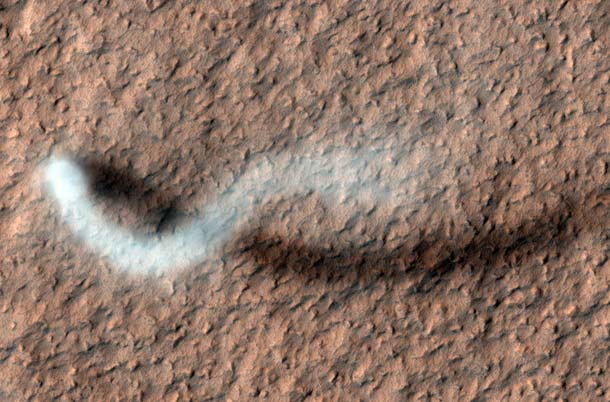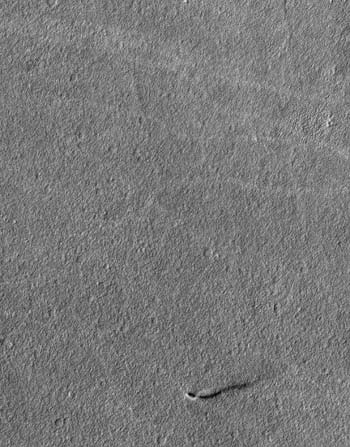Create a free profile to get unlimited access to exclusive videos, sweepstakes, and more!
Between the Devil and the deep Red Planet
Mars is a pretty incredible place. It's way too easy to easy to think of it as a cold, dry, dead world, but that's not really true: It has an atmosphere (though thin), it has seasons, and it even has weather.
Circling the Red Planet is the Mars Reconnaissance Orbiter, and with its HiRISE camera it has a fantastic view of the changing face of the planet. And it so happens that sometimes MRO is looking at just the right place, at just the right time, to capture astonishing events ... like this magnificent twisting dust devil towering over the landscape:
Holy wow! [Click to barsoomenate.]
This picture is just amazing. Dust devils are wind vortices, like tornadoes, but generally not as violent. They form when sunlight warms the surface of Mars. The air just above it gets warmer and rises. If there is a crosswind, it can blow across the rising air and start it spinning like waves breaking on a beach. But since the air is rising, it can lift up vertically while still spinning, forming a dust devil.
I've seen them here on Earth all the time; driving across the American southwest one day I saw dozens, including one that was easily a hundred meters across. And so it happens on Mars too. But I've never seen one like this! Given the shadow and height of the Sun when this shot was taken, the devil must have been 800 meters high -- a half a mile! That's huge.
The dust devil actually was relatively vertical until a height of about 250 meters above the ground, where the wind caught it and swept it back into that serpentine shape. The path of the dust devil was actually fairly straight; it's just the plume being whipped around that makes it look wavy (the shadow on the surface adds a wonderful depth to it as well).
Devils commonly leave behind interesting tracks on the ground as well as they sweep away dust, which can be phenomenally beautiful and intricate. That's not easily apparent in this closeup, but I've included a shot here that shows a much larger area -- you can see the dust devil at the bottom for scale -- and there are bright tracks all over the place, where earlier devils have swept up surface material.
As the folks at HiRISE point out, it's interesting that these tracks are bright and not dark as usual. The area seen here has thick dust that is too heavy to be picked up by the devil's winds, but there is lighter dust scattered around on top of the thicker material. It's likely that after the dust devil moves, the lighter, brighter material swirls and settles behind the vortex, forming those tracks.
Dust devils are most common in the spring, when atmospheric conditions are best for them, and it happens to be late spring in this location on Mars. And having seen dust devils like this on Earth -- where they are mesmerizing and fascinating -- I have to wonder. Will my descendants someday put on a pressure suit and protective gear, walk out an airlock into a rusty landscape and butterscotch sky, and see a phenomenon like this towering above them?
I hope so. I surely do.
Related Posts:
- The artwork of the Martian landscape
- Martian dunes under the microscope
- A tornado made of fire. Seriously.
- The devil is in the details




























